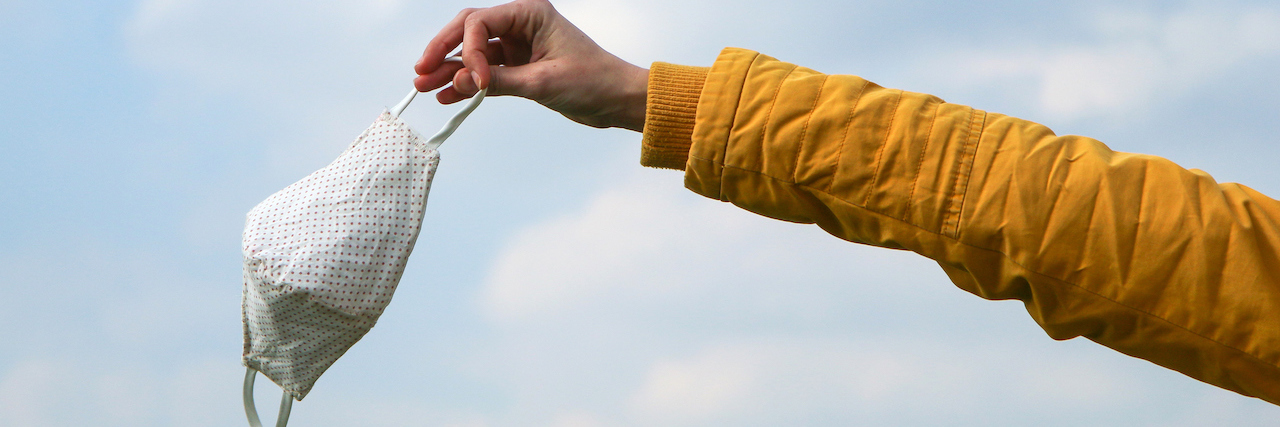What to Do If You Can't Wear a Face Mask
Editor's Note
Join The Mighty’s Coronavirus group to connect with other Mighties living through the pandemic. Read the latest updates, share helpful tips, or give and receive virtual support.
Despite mixed advice early on in the COVID-19 pandemic, face masks have emerged as one of the most important tools we have to prevent COVID-19. When worn properly, studies suggest face masks can significantly slow the spread of the virus in communities. The Centers for Disease Control and Prevention (CDC) has since updated its guidance to recommend everyone wear a face mask while out in public. Some cities and states now require masks.
No matter the importance for the health and safety of you, your loved ones and the community, there’s no getting around that for some people, wearing a face mask doesn’t seem like an option. Maybe the restriction to your breathing causes a spike in panic or the feel of elastic around your ears triggers your sensory sensitivities. If you’re struggling to wear a face mask, you’re not alone.
“I keep having trouble with moisture buildup and heat trapping with my homemade ones, but I don’t want to buy one if I’m going to have those sensory problems,” said Mighty community member Alice N. “I definitely need a solution.”
Here are some of the most common face mask difficulties and some suggestions for problem-solving:
Face Masks Cause Anxiety or Breathing Issues
Wearing a face mask definitely impacts your breathing. If you already struggle with breathing issues or discomfort, wearing a face mask may be a major source of anxiety. In addition, feeling like you can’t breath can trigger anxiety and even panic attacks for some people. These are valid concerns.
Ross Feinman, an emergency department nurse at Long Island Jewish Medical Center, said if you’re having trouble with wearing masks, it’s OK to take breaks when you’re not around other people. He said if you’re alone in a car or out at a time or place when you’re not near anyone else, you can take a mask break.
“It’s not a virus that’s just in the air everywhere, it comes from other people,” Feinman told The Mighty. “Taking those breaks is a really good tip, and those are the safe ways that people can take breaks.”
When you remove the mask, avoid touching anything other than its straps and don’t touch your face. Carry hand sanitizer, and wash your hands thoroughly when you get home. Be prepared to safely put your mask back on if other people enter your area, and mask or not, stay at least 6 to 12 feet away from other people.
There are other reasons wearing a face mask can trigger your anxiety. For example, Feinman said the source of anxiety may be more related to the fear of the virus and getting sick when you see people wearing masks. It’s important to identify the source of your face mask-related anxiety so you can work with your therapist or loved ones to come up with some strategies.
When you remove it, do so from the elastic at the back of the ears
If you touch the front of the mask, you will spread the virus (if it’s there) onto your hands.
For the same reason, don’t touch the mask to lower it to speak over and wash after every use.#lockdownextension pic.twitter.com/IuajDvOOgO
— Aderonke Omo Dairo (@aderonkedairo) May 6, 2020
Face Masks and Sensory Sensitivities
Face masks are full of potential discomforts if you have sensory sensitivities — the fabric against your face may not feel good, nor the straps around your ears.
It may be possible to reduce sensitivities if the feel of the mask on your face is the main issue:
- Look for sensory-friendly pre-made masks: Companies like SensaCalm have developed masks with the same fabrics as its other clothing
- Look for sensory-friendly fabrics: If you know certain fabrics or features are comfortable in other clothing (like no seams) try to find (or make) a mask that meets those needs and see how it works
- Use an alternative face covering: Find a face mask alternative (like a bandana or other fabric) that eliminates some of the sensory sensitivities
“Technically any sort of face covering, whether it’s a bandana or fabric is OK,” Feinman said. “Some people do find making [masks] out of their own cloth, their own fabrics, are more comfortable. Also, if they have anxiety, it’s something that they are in control of.”
If your sensory sensitivities are triggered more by the elastic straps (or anything) around the ears, you can try a mask design that uses strings that tie around the head. Other options include attaching the elastic straps to hair clips or a headband with buttons. According to Margaret Krepp, RN, director of patient care services at Huntington Hospital, this is a strategy health care workers often rely on.
“Masks worn by the public can often be more comfortable with the use of headbands with buttons, which help to relieve the pressure behind the ears,” Krepp told The Mighty.
Face Masks for Kids
Whether due to anxiety, sensory sensitivities or not understanding why so many people are wearing face masks, it can be difficult to get kids to wear masks. Some parents are turning to kid-friendly masks that make the experience a little more fun and palatable, in addition to being mindful of kid preferences and comfort levels.
“I’m going to buy my son one like this I think he will be more likely to wear,” shared Mighty community member Gina R.

“Etsy has a lot of custom mask makers — try different styles or a unique, personalized fabric,” Mighty community member Jennifer N. added. “I got airplanes and my son’s favorite logo, United. Also, I’m sure someone would work directly with a customer for sensory needs.”
If your child is feeling particularly anxious about COVID-19 or wearing a face mask, psychotherapist and Mighty contributor Kate Sheehan, LCSW, recommended several strategies, including giving kids a sense of control with choices.
“Anxiety can overwhelm our brains and make it hard to come up with a plan for ourselves,” Sheehan wrote. “Offering choices to a child with anxiety can help them make better decisions.”
Accessible Masks for Deaf and Hard-of-Hearing People
Face masks have proven to be a major accessibility issue for deaf and hard-of-hearing people. Masks that completely block your lips mean those who rely on lip-reading can no longer participate in conversations. Face masks dampen your speech, which can make it difficult for people who are hard-of-hearing or rely on Cochlear implants to understand what you’re saying.
All of these issues — including the inability to clearly read facial expressions — are heightened by the need to stay at least six feet away from others.
Some companies have created face masks that have a clear plastic front that both protects the wearer and allows people to effectively read lips. The Hearing, Speech & Deaf Center created a pattern so you can make your own clear-fronted mask. Face shields can also be a good alternative.
Work with deaf loved ones or community members to co-create a more accessible way to communicate. For example, you may need to speak more slowly so your words aren’t as muddled by the mask or ensure you’re making deliberate eye contact. Depending on the situation, it may be helpful to communicate through written modes as well.
Have a question about coronavirus/covid-19? Use the ASL Now COVID-19 Hotline! https://t.co/qxbekDh6VH
— nad1880 (@NAD1880) March 23, 2020
What to Do If You Can’t Wear a Mask
It can be frustrating and distressing when face masks aren’t comfortable or cause symptoms of your other conditions. And sometimes, problem-solving the face mask itself won’t be enough.
There are a few groups of people the CDC says should not wear face masks:
- Toddlers and babies under the age of 2
- People with a health condition that causes trouble breathing
- Those who can’t remove a face mask without help
If you’re not in one of those limited groups, Feinman said you really shouldn’t be out in the community around other people without a face mask. Where possible, rely on delivery services or loved ones to get essential items and only go out at times and in areas when you won’t encounter other people.
This may be hard to hear, but Feinman highlighted it’s essential until we have a better grip on treating and preventing COVID-19.
“The purpose [of masks] is not to protect you, it’s actually to protect other people from you,” Feinman said, adding:
Until we have a better grip on what’s going on. I don’t think they should be really that close to or around people … because, again, the rationale is that we can all be carriers without any symptoms, and we could be giving the virus to other people unknowingly.
Struggling with anxiety due to COVID-19? Check out the following articles from our community:
- 6 Tips If You’re Anxious About Being Unable to Go to Therapy Because of COVID-19
- 7 Things to Do If Social Distancing Is Triggering Your Depression
- What to Do If the Coronavirus Health Guidelines Are Triggering Your Anxiety or OCD
- How Can You Tell the Difference Between Anxiety and COVID-19 Symptoms?
- Feeling Calm in the Midst of the Coronavirus Pandemic Might Be a Trauma Response
Header image via iStock/Getty Images

